RENAULT KANGOO ZERO EMISSION 2012 X61 / 2.G Owners Manual
Manufacturer: RENAULT, Model Year: 2012, Model line: KANGOO ZERO EMISSION, Model: RENAULT KANGOO ZERO EMISSION 2012 X61 / 2.GPages: 213, PDF Size: 6.08 MB
Page 91 of 213
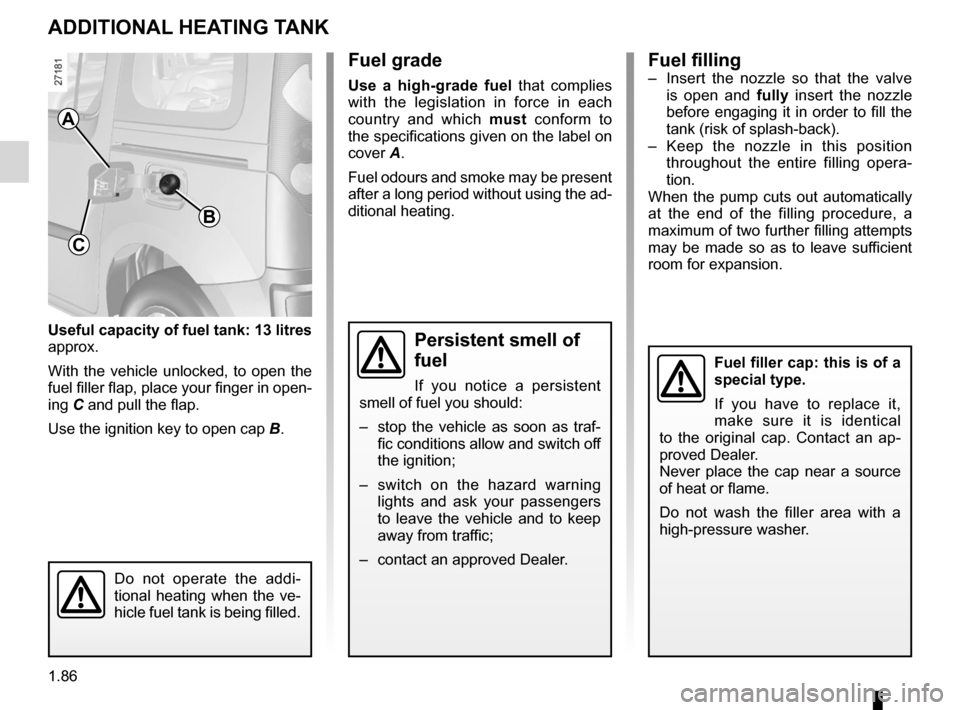
fuel filler cap ......................................... (up to the end of the DU)
fuel capacity ........................................... (up to the end of the DU)
fuel grade ............................................... (up to the end of the DU)
fuel filling ................................................ (up to the end of the DU)
additional tank capacity ........................ (up to the end of the DU)
additional heating fuel ...........................(up to the end of the DU)
additional heating additional heating fuel tank ............. (up to the end of the DU)
additional tank filling ............................. (up to the end of the DU)
additional heating tank ..........................(up to the end of the DU)
1.86
ENG_UD23011_2
Réservoir chauffage additionnel (X61 électrique - Renault)
ENG_NU_911-4_F61e_Renault_1
Additional heating tank
Useful capacity of fuel tank: 13 litres
approx.
With the vehicle unlocked, to open the
fuel filler flap, place your finger in open -
ing C and pull the flap.
Use the ignition key to open cap B.
ADDitiONAl heAtiNg tANK
Fuel grade
Use a high-grade fuel that complies
with the legislation in force in each
country and which must conform to
the specifications given on the label on
cover A.
Fuel odours and smoke may be present
after a long period without using the ad-
ditional heating.
A
c
B
Fuel filler cap: this is of a
special type.
If you have to replace it,
make sure it is identical
to the original cap. Contact an ap -
proved Dealer.
Never place the cap near a source
of heat or flame.
Do not wash the filler area with a
high-pressure washer.
Fuel filling– Insert the nozzle so that the valve
is open and fully insert the nozzle
before engaging it in order to fill the
tank (risk of splash-back).
– Keep the nozzle in this position
throughout the entire filling opera -
tion.
When the pump cuts out automatically
at the end of the filling procedure, a
maximum of two further filling attempts
may be made so as to leave sufficient
room for expansion.
Persistent smell of
fuel
If you notice a persistent
smell of fuel you should:
– stop the vehicle as soon as traf-
fic conditions allow and switch off
the ignition;
– switch on the hazard warning
lights and ask your passengers
to leave the vehicle and to keep
away from traffic;
– contact an approved Dealer.
Do not operate the addi -
tional heating when the ve-
hicle fuel tank is being filled.
Page 92 of 213
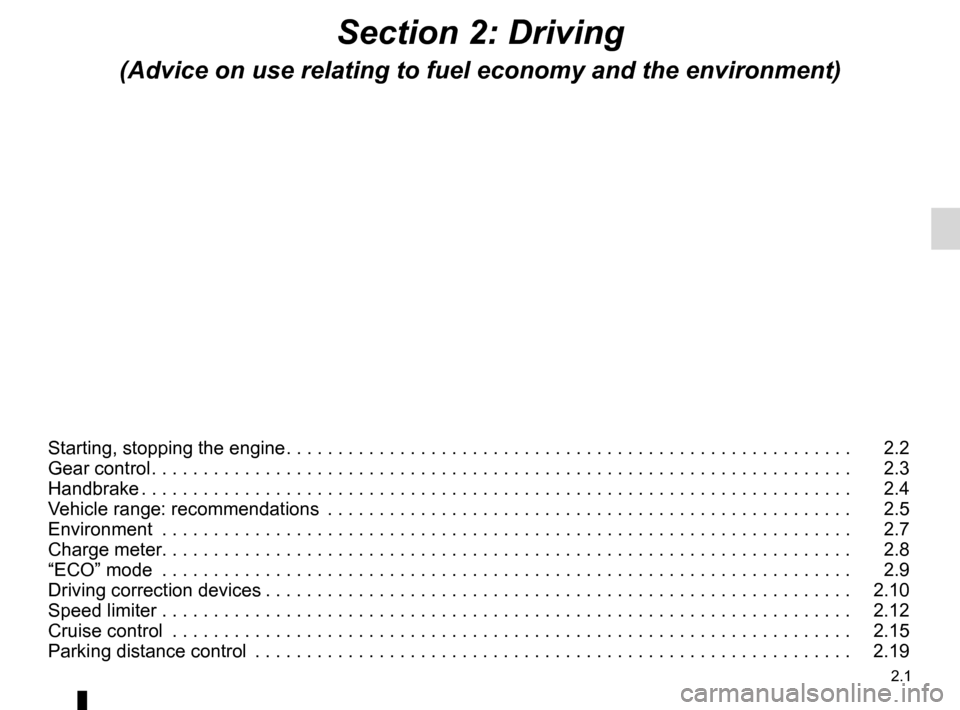
2.1
ENG_UD29093_4
Sommaire 2 (X61 - F61 - Renault)
ENG_NU_911-4_F61e_Renault_2
Section 2: Driving
(Advice on use relating to fuel economy and the environment)
Starting, stopping the engine . . . . . . . . . . . . . . . . . . . . . . . . . . . . . . . . . . . . . . . . . . . . . . . . . . . . . . . 2.2
Gear control . . . . . . . . . . . . . . . . . . . . . . . . . . . . . . . . . . . . . . . . . . . . . . . . . . . . . . . . . . . . . . . . . . . . 2.3
Handbrake . . . . . . . . . . . . . . . . . . . . . . . . . . . . . . . . . . . . . . . . . . . . . . . . . . . . . . . . . . . . . . . . . . . . . 2.4
Vehicle range: recommendations . . . . . . . . . . . . . . . . . . . . . . . . . . . . . . . . . . . . . . . . . . . . . . . . . . . 2.5
Environment . . . . . . . . . . . . . . . . . . . . . . . . . . . . . . . . . . . . . . . . . . . . . . . . . . . . . . . . . . . . . . . . . . . 2.7
Charge meter . . . . . . . . . . . . . . . . . . . . . . . . . . . . . . . . . . . . . . . . . . . . . . . . . . . . . . . . . . . . . . . . . . . 2.8
“ECO” mode . . . . . . . . . . . . . . . . . . . . . . . . . . . . . . . . . . . . . . . . . . . . . . . . . . . . . . . . . . . . . . . . . . . 2.9
Driving correction devices . . . . . . . . . . . . . . . . . . . . . . . . . . . . . . . . . . . . . . . . . . . . . . . . . . . . . . . . . 2.10
Speed limiter . . . . . . . . . . . . . . . . . . . . . . . . . . . . . . . . . . . . . . . . . . . . . . . . . . . . . . . . . . . . . . . . . . . 2.12
Cruise control . . . . . . . . . . . . . . . . . . . . . . . . . . . . . . . . . . . . . . . . . . . . . . . . . . . . . . . . . . . . . . . . . . 2.15
Parking distance control . . . . . . . . . . . . . . . . . . . . . . . . . . . . . . . . . . . . . . . . . . . . . . . . . . . . . . . . . . 2.19
Page 93 of 213
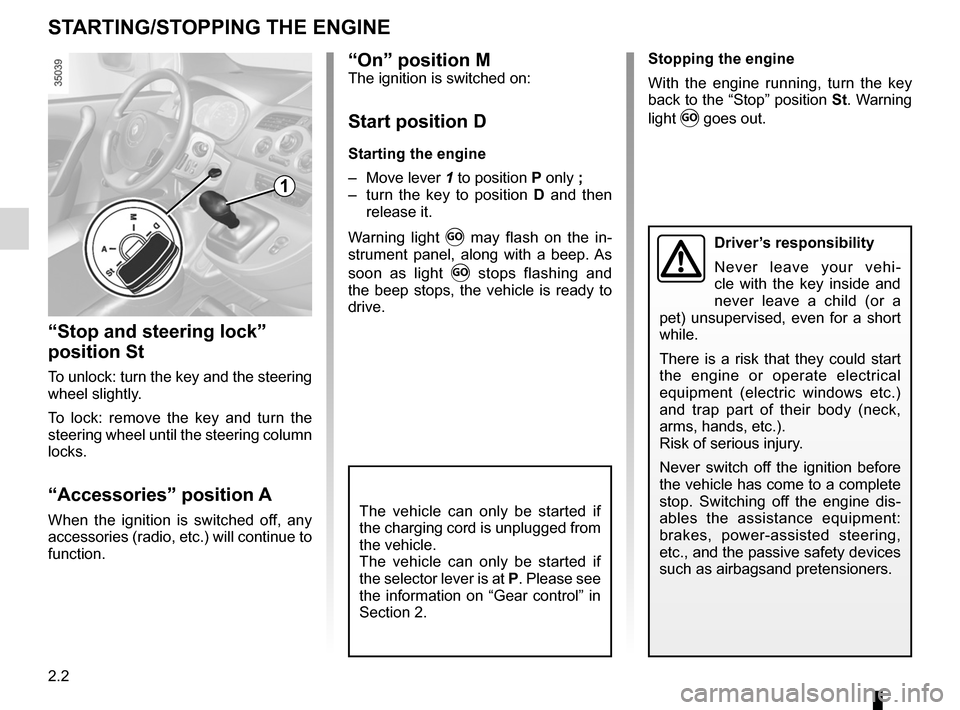
2.2
ENG_UD25284_3
Démarrage (X61 électrique - Renault)
ENG_NU_911-4_F61e_Renault_2
Starting, stopping the engine
“On” position MThe ignition is switched on:
Start position D
Starting the engine
– Move lever 1 to position P only ;
– turn the key to position D and then
release it.
Warning light
Ṑ may flash on the in -
strument panel, along with a beep. As
soon as light
Ṑ stops flashing and
the beep stops, the vehicle is ready to
drive.
Stopping the engine
With the engine running, turn the key
back to the “Stop” position St. Warning
light
Ṑ goes out.
Starting/St OPPing tHE EnginE
Driver’s responsibility
Never leave your vehi -
cle with the key inside and
never leave a child (or a
pet) unsupervised, even for a short
while.
There is a risk that they could start
the engine or operate electrical
equipment (electric windows etc.)
and trap part of their body (neck,
arms, hands, etc.).
Risk of serious injury.
Never switch off the ignition before
the vehicle has come to a complete
stop. Switching off the engine dis -
ables the assistance equipment:
brakes, power-assisted steering,
etc., and the passive safety devices
such as airbagsand pretensioners.
“Stop and steering lock”
position St
To unlock: turn the key and the steering
wheel slightly.
To lock: remove the key and turn the
steering wheel until the steering column
locks.
“accessories” position a
When the ignition is switched off, any
accessories (radio, etc.) will continue to
function.The vehicle can only be started if
the charging cord is unplugged from
the vehicle.
The vehicle can only be started if
the selector lever is at P. Please see
the information on “Gear control” in
Section 2.
1
Page 94 of 213
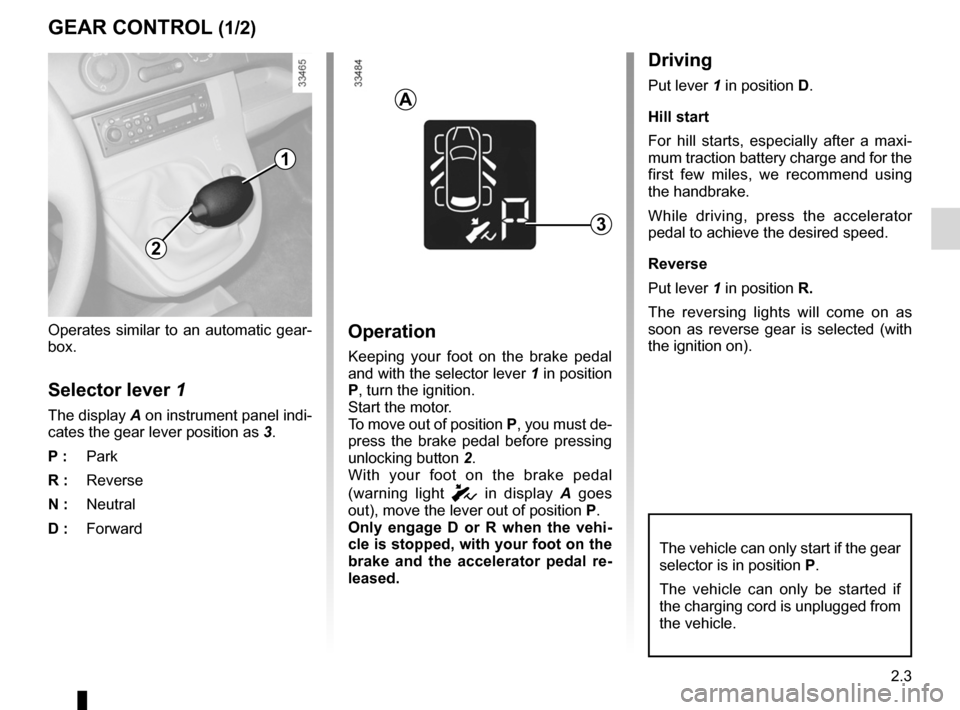
changing gear ....................................... (up to the end of the DU)
driving ................................................... (up to the end of the DU)
reverse gear selecting .......................................... (up to the end of the DU)
speed control ........................................ (up to the end of the DU)
gear lever .............................................. (up to the end of the DU)
electric vehicle driving .............................................................. (current page)
2.3
ENG_UD26205_3
Commande de vitesse (X61 électrique - Renault)
ENG_NU_911-4_F61e_Renault_2
Gear control
gEar cOntrOl (1/2)
Operates similar to an automatic gear-
box.
Selector lever 1
The display A on instrument panel indi -
cates the gear lever position as 3.
P : Park
r : Reverse
n : Neutral
D : Forward
Operation
Keeping your foot on the brake pedal
and with the selector lever 1 in position
P, turn the ignition.
Start the motor.
To move out of position P, you must de-
press the brake pedal before pressing
unlocking button 2.
With your foot on the brake pedal
(warning light
c in display A goes
out), move the lever out of position P.
Only engage D or r when the vehi -
cle is stopped, with your foot on the
brake and the accelerator pedal re -
leased.
1
Driving
Put lever 1 in position D.
Hill start
For hill starts, especially after a maxi -
mum traction battery charge and for the
first few miles, we recommend using
the handbrake.
While driving, press the accelerator
pedal to achieve the desired speed.
reverse
Put lever 1 in position r.
The reversing lights will come on as
soon as reverse gear is selected (with
the ignition on).
3
2
a
The vehicle can only start if the gear
selector is in position P.
The vehicle can only be started if
the charging cord is unplugged from
the vehicle.
Page 95 of 213
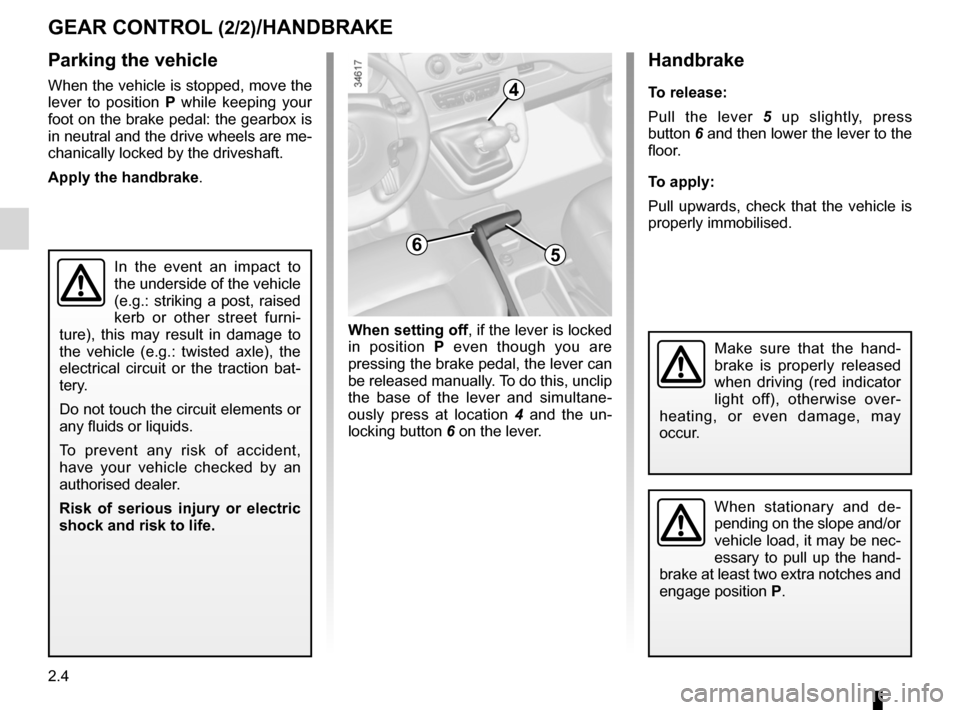
handbrake.............................................................. (current page)
2.4
ENG_UD26205_3
Commande de vitesse (X61 électrique - Renault)
ENG_NU_911-4_F61e_Renault_2
Handbrake
t o release:
Pull the lever 5 up slightly, press
button 6 and then lower the lever to the
floor.
t o apply:
Pull upwards, check that the vehicle is
properly immobilised.
Handbrake
gEar cOntrOl (2/2)/HanDbrakE
Parking the vehicle
When the vehicle is stopped, move the
lever to position P while keeping your
foot on the brake pedal: the gearbox is
in neutral and the drive wheels are me-
chanically locked by the driveshaft.
apply the handbrake.
In the event an impact to
the underside of the vehicle
(e.g.: striking a post, raised
kerb or other street furni -
ture), this may result in damage to
the vehicle (e.g.: twisted axle), the
electrical circuit or the traction bat -
tery.
Do not touch the circuit elements or
any fluids or liquids.
To prevent any risk of accident,
have your vehicle checked by an
authorised dealer.
r isk of serious injury or electric
shock and risk to life.
When setting off, if the lever is locked
in position P even though you are
pressing the brake pedal, the lever can
be released manually. To do this, unclip
the base of the lever and simultane -
ously press at location 4 and the un -
locking button 6 on the lever.
When stationary and de -
pending on the slope and/or
vehicle load, it may be nec-
essary to pull up the hand -
brake at least two extra notches and
engage position P.
Make sure that the hand -
brake is properly released
when driving (red indicator
light off), otherwise over -
heating, or even damage, may
occur.
6
4
5
Page 96 of 213

driving ................................................... (up to the end of the DU)
practical advice ..................................... (up to the end of the DU)
energy consumption ............................. (up to the end of the DU)
vehicle range ........................................ (up to the end of the DU)
energy saving ....................................... (up to the end of the DU)
energy saving ............................................. (up to the end of the DU)
charge meter ......................................................... (current page)
»ECO» mode function ........................................... (current page)
electric vehicle vehicle range ................................................... (current page)
electric vehicle driving .............................................................. (current page)
2.5
ENG_UD28187_3
Conseils : économie d\’énergie (X61 électrique - Renault)
ENG_NU_911-4_F61e_Renault_2
Vehicle range: recommendations
VEHiclE rangE: recommendations (1/2)
The vehicle range is approved for a
mixed NEDC cycle (New European
Driving Cycle).
In real usage, the range of an electric
vehicle may vary depending on several
factors over which you have partial con-
trol, which may make a considerable
difference to the vehicle range. These
factors are:
– speed and driving style;
– type of road;
– heating level;
– tyres;
– vehicle loading.
Furthermore, activating ECO mode en-
ables the vehicle to automatically take
charge of all energy-consuming ele -
ments to reduce their consumption to
the fullest possible extent. Please refer
to the information on “Eco-driving” in
Section 2.
Speed and driving style
High speeds will reduce your vehicle’s
range.
A “sporty” driving style reduces your
vehicle range: opt for a “lighter” driving
style. Drive at a constant speed.
Adapt your driving style to avoid exces-
sive energy consumption. Please refer
to the information on “Charge meter” in
Section 2.
Anticipate traffic changes by lifting your
foot off the accelerator pedal in order to
recover energy. Please refer to the in
-
formation on “Charge meter” in Section
2.
Favour ECO mode (please see infor -
mation about “ECO mode function” in
Section 2).
road type
Do not try to maintain the same speed
up a hill, accelerate no more than you
would on flat ground. Keep your foot
in the same position on the accelera -
tor pedal.
Page 97 of 213
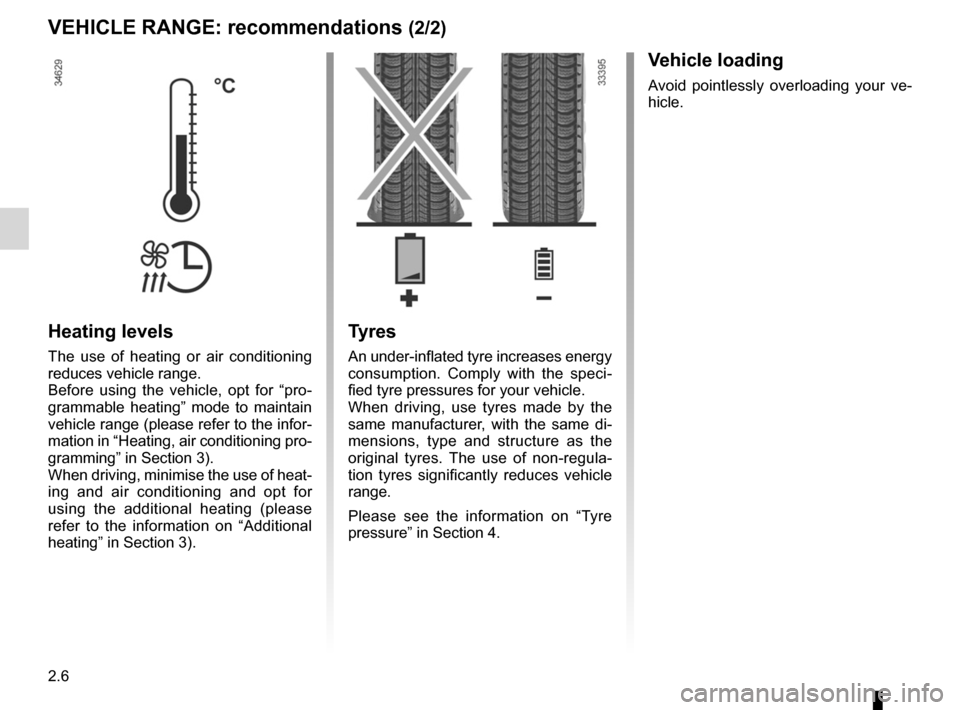
heating, air conditioning: programming ................. (current page)
2.6
ENG_UD28187_3
Conseils : économie d\’énergie (X61 électrique - Renault)
ENG_NU_911-4_F61e_Renault_2
VEHiclE rangE: recommendations (2/2)
Heating levels
The use of heating or air conditioning
reduces vehicle range.
Before using the vehicle, opt for “pro -
grammable heating” mode to maintain
vehicle range (please refer to the infor-
mation in “Heating, air conditioning pro-
gramming” in Section 3).
When driving, minimise the use of heat-
ing and air conditioning and opt for
using the additional heating (please
refer to the information on “Additional
heating” in Section 3).
t yres
An under-inflated tyre increases energy
consumption. Comply with the speci -
fied tyre pressures for your vehicle.
When driving, use tyres made by the
same manufacturer, with the same di -
mensions, type and structure as the
original tyres. The use of non-regula -
tion tyres significantly reduces vehicle
range.
Please see the information on “Tyre
pressure” in Section 4.
Vehicle loading
Avoid pointlessly overloading your ve -
hicle.
Page 98 of 213
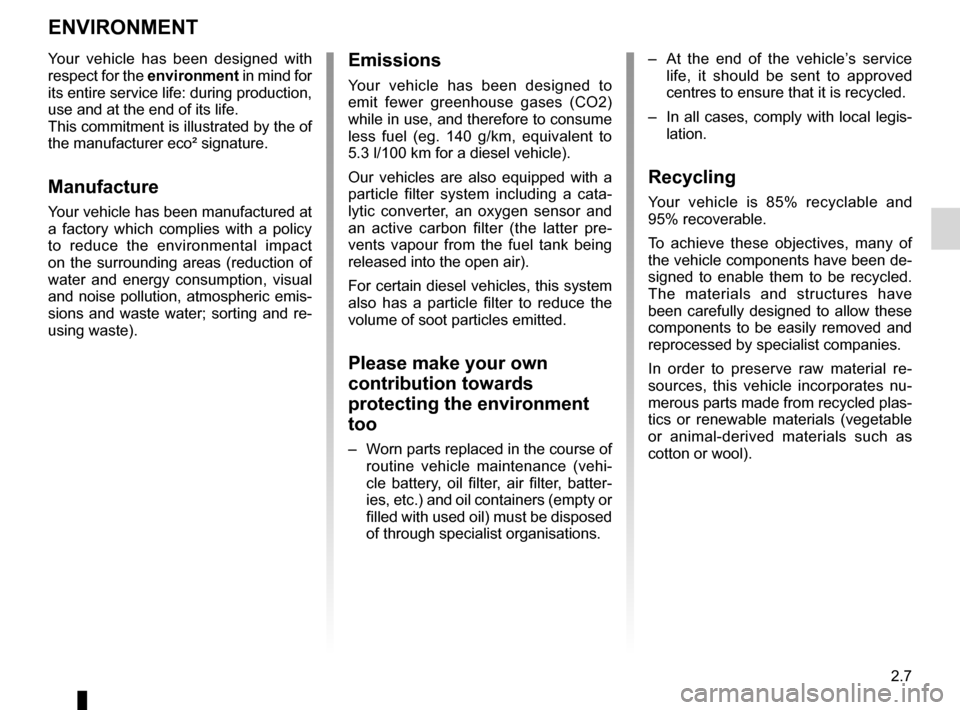
environment .......................................... (up to the end of the DU)
2.7
ENG_UD25716_1
Environnement (sans marque) (X44 - X45 - X77 - X81 - X85 - X90 - X91 - X83 - X61 - TEST - X95 - J95 - R95 - F90 Ph2 - X33 - X47 - X43 - X38 - H79 - X62 - X32 - X09 -
ENG_NU_911-4_F61e_Renault_2
Environment
EnVirOnMEnt
Emissions
Your vehicle has been designed to
emit fewer greenhouse gases (CO2)
while in use, and therefore to consume
less fuel (eg. 140 g/km, equivalent to
5.3 l/100 km for a diesel vehicle).
Our vehicles are also equipped with a
particle filter system including a cata -
lytic converter, an oxygen sensor and
an active carbon filter (the latter pre -
vents vapour from the fuel tank being
released into the open air).
For certain diesel vehicles, this system
also has a particle filter to reduce the
volume of soot particles emitted.
Please make your own
contribution towards
protecting the environment
too
– Worn parts replaced in the course of
routine vehicle maintenance (vehi -
cle battery, oil filter, air filter, batter -
ies, etc.) and oil containers (empty or
filled with used oil) must be disposed
of through specialist organisations. –
At the end of the vehicle’s service
life, it should be sent to approved
centres to ensure that it is recycled.
– In all cases, comply with local legis -
lation.
recycling
Your vehicle is 85% recyclable and
95% recoverable.
To achieve these objectives, many of
the vehicle components have been de-
signed to enable them to be recycled.
The materials and structures have
been carefully designed to allow these
components to be easily removed and
reprocessed by specialist companies.
In order to preserve raw material re -
sources, this vehicle incorporates nu -
merous parts made from recycled plas-
tics or renewable materials (vegetable
or animal-derived materials such as
cotton or wool).
Your vehicle has been designed with
respect for the
environment in mind for
its entire service life: during production,
use and at the end of its life.
This commitment is illustrated by the of
the manufacturer eco² signature.Manufacture
Your vehicle has been manufactured at
a factory which complies with a policy
to reduce the environmental impact
on the surrounding areas (reduction of
water and energy consumption, visual
and noise pollution, atmospheric emis-
sions and waste water; sorting and re-
using waste).
Page 99 of 213
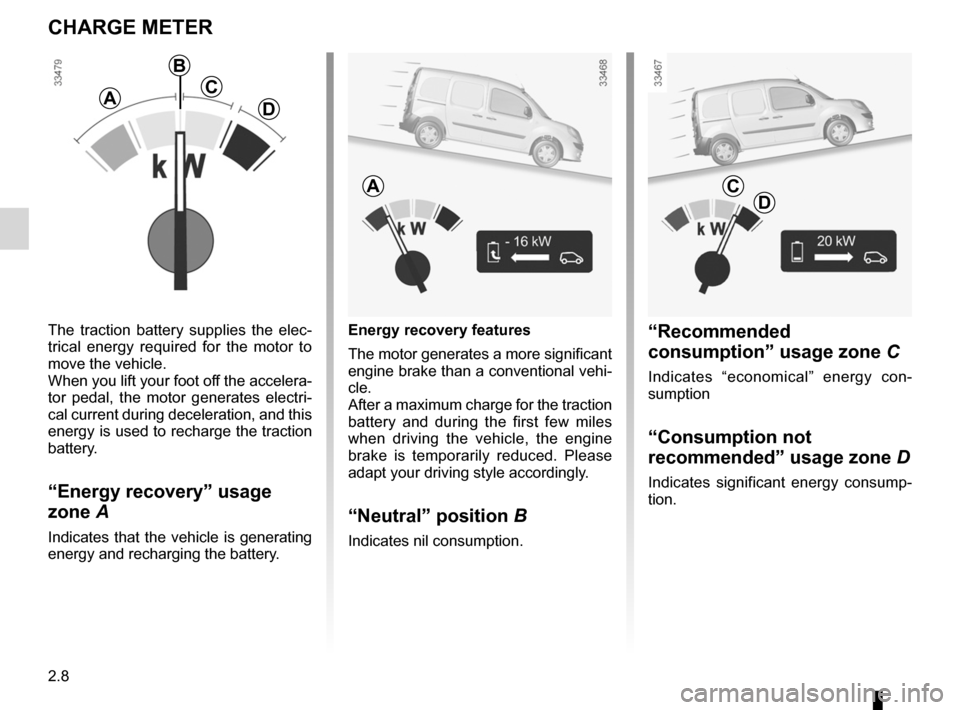
traction battery ....................................................... (current page)
energy consumption .............................................. (current page)
charge meter ......................................................... (current page)
energy range ................................................................ (current page)
energy consumption .................................................... (current page)
energy charge meter (function) .................................... (current page)
energy recovery ........................................................... (current page)
energy recovery ..................................................... (current page)
2.8
ENG_UD23007_2
Economètre (X61 électrique - Renault)
ENG_NU_911-4_F61e_Renault_2
Charge meter
cHargE MEtEr
The traction battery supplies the elec -
trical energy required for the motor to
move the vehicle.
When you lift your foot off the accelera -
tor pedal, the motor generates electri -
cal current during deceleration, and this
energy is used to recharge the traction
battery.
“Energy recovery” usage
zone A
Indicates that the vehicle is generating
energy and recharging the battery. Energy recovery features
The motor generates a more significant
engine brake than a conventional vehi-
cle.
After a maximum charge for the traction
battery and during the first few miles
when driving the vehicle, the engine
brake is temporarily reduced. Please
adapt your driving style accordingly.
“neutral” position
B
Indicates nil consumption.
“recommended
consumption” usage zone C
Indicates “economical” energy con -
sumption
“consumption not
recommended” usage zone D
Indicates significant energy consump -
tion.
a
b
c
D
acD
Page 100 of 213
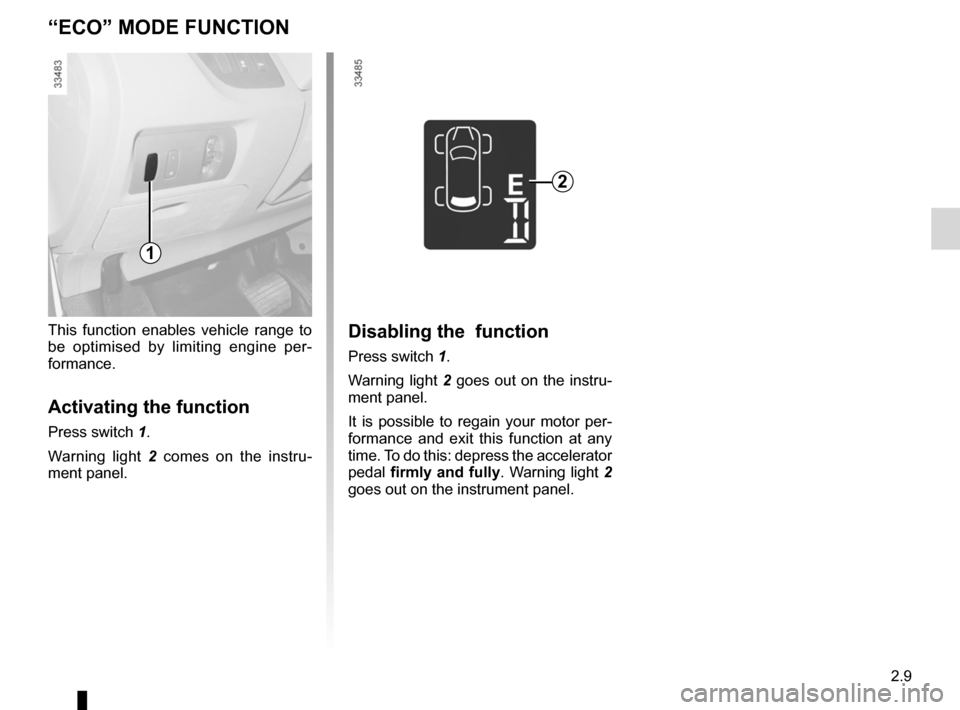
energy»ECO» mode ................................................... (current page)
»ECO» mode function ........................................... (current page)
electric vehicle »ECO» mode ................................................... (current page)
2.9
ENG_UD23479_1
Mode ECO (X61 électrique - Renault)
ENG_NU_911-4_F61e_Renault_2
“ECO” Mode
“EcO” MODE FunctiOn
This function enables vehicle range to
be optimised by limiting engine per -
formance.
activating the function
Press switch 1.
Warning light 2 comes on the instru -
ment panel.
Disabling the function
Press switch 1.
Warning light 2 goes out on the instru-
ment panel.
It is possible to regain your motor per-
formance and exit this function at any
time. To do this: depress the accelerator
pedal firmly and fully. Warning light 2
goes out on the instrument panel.
1
2